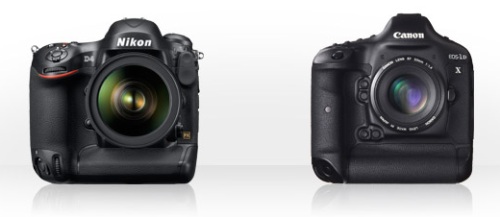Today’s professional/prosumer cameras finally provide the quality of 35-mm film cameras, but it has taken 15 or more years to get to that level of parity. Let’s take a quick look back and see just how far we have come with digital cameras in this very short time. Do you remember your first digital camera in the late 90s? Mine was a Kodak and it used double-A batteries, had 1-Mpixel resolution and was pretty useless for anything but still compositions or someone walking very slowly in a well-lit venue. However, journalists were finding that it could be cutting edge because you could take a photo at a trade show and post it to your web site the same day. It was new and exciting but pretty useless if you needed to show any details or any action.
Now, we can take excellent pictures in low light, with action, and even take HD movies with quality sound. For example, the Nikon D4 or the Canon 1Dx are currently the top-of-the-line cameras that provide some amazing functions, and great results — if you know how to use the camera’s capabilities.

The Nikon D4 and Canon 1D X are very advanced tools that make taking pictures fun
These cameras target sports and action photography and use 24 x 36-mm CMOS sensors to provide excellent light-gathering capability. The Nikon’s 16-Mixel resolution (not as much as the 36 Mpixels on the Nikon D800), and the 1D X 18-Mpixel images are more than enough to get amazing detail — but you still need to take the time to learn how to use it. You still need to know about the best lighting for a given situation or what speed and f-stop will give you great results. In the hands of the experienced user it will turn out fantastic photos faster than most other cameras, but it won’t make you a professional if you haven’t spent the time learning the craft. This camera can provide clear pictures in low light and at high ISOs. They also have auto-ISO so you can get the highest ISO rating, and, of course, there is an auto focus for your action shots.

Catching the exact moment gets easier (Courtesy of Nikon)
Both the Nikon D4 and the Canon EOS-1D X are amazing cameras that will meet your optic/camera needs, no matter what your requirements. Canon has upgraded to a full-frame format that now compares favorably to the Nikon for use in low-light situations. They both use a Bayer filter technology for arranging RGB color filters on a square grid of photosensors (most commonly used type in single-chip digital image sensors). The two cameras have similar yet very impressive autofocus functionality. The D4 uses a 51-point autofocus process while the 1D X implements a 61-point process — that when coupled with scene recognition sensors you get about 100,000 points and a camera that seems almost psychic about what you were trying to photograph. That means you can set the autofocus on automatic for anything that moves and the cameras will manage to ignore distractions, find the subject’s eyes and get the perfect in-focus shot. For those action shots, the 1D X offers 12 frames/s and the D4 provides 10 frames/s. The shutter speed for both cameras can be set from 1/8,000 to a really long 30 s. One thing that I haven’t determined is about the electronics put into the battery-level gauge. This technology has improved dramatically over the past few years providing much more accurate readings than was previously available and allowing you to know more precisely when you need to recharge or replace your battery. Regardless, the specs say you can get 1,800 shots from the Canon 1D X and 3,000 clicks from the Nikon D4 (about 40% more). Further research states that Canon gets 1,120 and Nikon gets 2,600 photos per fully charged battery.
For the photo/video journalist type, both cameras offer an audio note taking function as you click away. And, for those times when you are taking pictures in very low light and you need to change functions, you will find the backlit buttons on the D4 most helpful. As you would expect, these are not inexpensive with the Canon 1D X carrying a price tag of $6,800 and the Nikon D4 costing $6,000. Find more in-depth comparison specifications at http://www.kenrockwell.com/tech/comparisons/2012-04-dslrs.htm or go to Nikon D4 or Canon 1D X .
Advertisement
Learn more about Electronic Products Magazine





